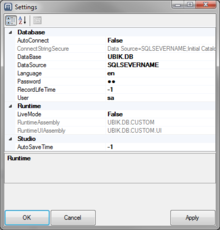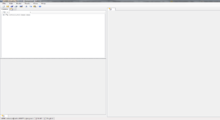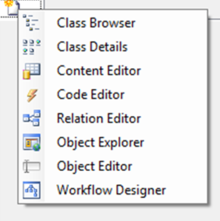Difference between revisions of "UBIK Studio Basics"
(→Create new MetaClass) |
(→Create new MetaClass) |
||
| Line 143: | Line 143: | ||
=== Create new MetaClass === | === Create new MetaClass === | ||
| − | # Create a new MetaClass via | + | # Create a new MetaClass via ''Derive new object'' from the context menu |
# Open the control ''Object Editor'' | # Open the control ''Object Editor'' | ||
# Set the newly created MetaClass to the control | # Set the newly created MetaClass to the control | ||
Revision as of 22:21, 9 March 2013
UBIK® Studio is the server application and administrative tool for creating and modifying UBIK® object models. Transfer your entitiy-relationship-model into UBIK® MetaClasses and MetaProperties and build up necessary relations. It is also the instrument of your choice to manage instances of MetaClasses, edit their property values and create actual relations between instance objects. This section will provide you with more information on the user interface.
Prerequisites
Options
Locate and click the menu Edit → Options. Press Apply or OK when you're finished changing the settings, or Cancel if you don't want your changes to be saved. The settings are user-specific and will be stored in your local Windows user profile.
In the options you can configure your database connection by the following parameters
| Parameter | Purpose |
|---|---|
| AutoConnect | If set to true, the system will attempt to automatically connect to the configured database on start up |
| DataBase | The name of your SQL Server |
| DataSource | SQL server instance (specify a server via host name, UNC, IP, ...) |
| Language | Set the desired database language in ISO639-1 syntax |
| User | SQL user name |
| Password | SQL user password |
Take care that the specified SQL user has appropriate permissions on the database.
Additional options are
| Parameter | Purpose |
|---|---|
| LiveMode | Use the relational database structure (true) or the Sandbox structure (false) |
| RecordLifeTime | Set how long records are valid before the will be requeried for changes by the core; -1 to turn off |
| AutoSaveTime | Set how often UBIK® Studio should save all unsaved objects automatically, in minutes; -1 to turn off |
Command line arguments
The following arguments can be passed to and will be recognized by the UBIK.Studio.exe:
| Parameter | Purpose |
|---|---|
| -NOCUSTOM | Don't attempt to load the customized object code |
| -NOCUSTOMUI | Don't attempt to load the customized UI elements |
| -CUSTOMVERSION:version | Attempt to load a specific deployed version of the customizing instead of the currently released one. Use this option if you want to test a specific customizing, without releasing it to all users. |
Working with UBIK® Studio
Menu and status strip
Menu and toolbar
Status strip
The status strip displays the following information, from left to right:
| Initial value | Purpose |
|---|---|
| DB | Current database: once connected, it will show the connection in the format Instance@Server |
| NOT INITIALIZED | Current Customizing: when successfully loaded, it will display the version information of the instantiated customizing assembly, -1.-1.-1 if loading failed |
| CULTURE | Current language and culture in ISO639-1 format |
| SESSION | Displays the name of the Login of the current Session; Right click on this item to switch into Admin mode |
Working area and controls
The main window of UBIK® Studio is split into 3 sections, where each of the 3 areas can hold an arbitrary amount of controls. The arrangement of the controls is user specific and can be saved. In addition to the predefined sections, the user interface can be extended with working windows, where each working window can again hold any amount of controls:
- View → New Working Window or Ctrl+W
However, such working windows are considered temporary and are therefore not made persistent when the layout is saved.
Each control provides different functionality for object creation/modification. Clicking the header of an empty tab strip in one of these areas with the left mouse button will bring up a context menu, that allows you to create a new tab page hosting one of the following controls:
| Control | Description |
|---|---|
| Class Browser | Navigate through the MetaClasses and instances |
| Class Details | Design MetaClasses |
| Bulk Editor | Create and edit instances |
| Code Editor | Implement customer specific functionality |
| Relation Editor | Relate objects and edit relational data |
| Object Explorer | Display and edit all exposed properties of objects (list style) |
| Object Editor | Graphical editor for changing object properties |
| Workflow Designer | Design and assign customer specific workflows |
Editing objects in general
Basically there are various ways to edit objects in the UBIK® database, each applicable for both, meta- and content objects. Use the following controls to edit
| Property | Control |
|---|---|
| Basic properties | Object Editor, Object Explorer, Content Editor |
| Relational data | Relation Editor |
| MetaClass details | Class Details |
| Events / object methods | Code Editor |
All controls require a similar workflow
- Open the control
- Set the object to be edited to the control via dragging the object and dropping it onto the header of the control’s tab
- The corresponding edit functionality will be available then
Creating and editing instances
MetaClasses
Create new MetaClass
- Create a new MetaClass via Derive new object from the context menu
- Open the control Object Editor
- Set the newly created MetaClass to the control
- Set name, description and namespace
- Save the changes
Technical implementation
The system creates a new instance of “CUSTOMMETACLASS” and sets the “INHERIT” property to the MetaClass the context menu was opened at. New derivates can be created for any system MetaClasss as “BASECLASS”, “REFERENCE”, “SELECTIVELIST”, … etc.
Inheritance
Classification
Link to Extended UBIK Metaclasses for Data Modelling
MetaProperties
Create new MetaProperty
A new MetaProperty can be created and automatically assigned to a MetaClass via the “Create new MetaProperty ” workflow. This workflow guides the user through the creation and configuration procedure of a MetaProperty and relates it to the selected MetaClass .
- Start Workflow “System / Create new MetaProperty ” from the context menu
- Set at least name, description and data type
- Change the MetaProperty ’s category if necessary
- Save the changes
- Optional configuration:
- - Reference
- - Selective list
- - Unit item
- - Format
- - Validation flag
- - Number of index keys
- - Default values
- - Initial values
Technical implementation
Without the workflow the user has to complete the following steps:
Step 1: Create new MetaProperty instance
- Navigate to the MetaClass “CUSTOMMETAPROPERTY”
- Create a new instance
- Set at least name, description and data type
- Change the MetaProperty’s category if necessary
- Save the changes
- Optional configuration:
- - Reference
- - Selective list
- - Unit item
- - Format
- - Validation flag
- - Number of index keys
- - Default values
- - Initial values
Step 2: Relate the instance of MetaProperty to a MetaClass
- Open the control “Class Details”
- Set the designated MetaClass to the control
- Add the MetaProperty either by dragging and dropping the MetaProperty's instance onto the MetaClass or by clicking the
 button in the menu
button in the menu - By clicking on the
 button the user has to navigate through the hierarchy to the appropriate MetaProperty
button the user has to navigate through the hierarchy to the appropriate MetaProperty
Settings
NEEDSVALIDATION
- explizite Speicherung des Validierungszeitstempels
- zB Verwendung am Client: der Wert dieser Eigenschaft muss am Client validiert, dh. zumindest einmal angeklickt, werden. Bei Verwendung der CLS_TASK Klassifizierung wird dieses Objekt als Finished gekennzeichnet, sobald ALLE solch konfigurierten MetaEigenschaften validiert sind.



